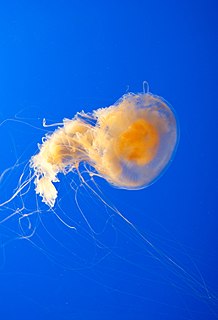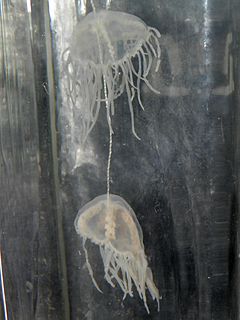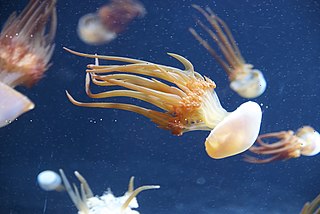
Jellyfish and sea jellies are the informal common names given to the medusa-phase of certain gelatinous members of the subphylum Medusozoa, a major part of the phylum Cnidaria. Jellyfish are mainly free-swimming marine animals with umbrella-shaped bells and trailing tentacles, although a few are anchored to the seabed by stalks rather than being mobile. The bell can pulsate to provide propulsion for highly efficient locomotion. The tentacles are armed with stinging cells and may be used to capture prey and defend against predators. Jellyfish have a complex life cycle; the medusa is normally the sexual phase, which produces planula larva that disperse widely and enter a sedentary polyp phase before reaching sexual maturity.

The Scyphozoa are an exclusively marine class of the phylum Cnidaria, referred to as the true jellyfish. It may include the extinct fossil group the Conulariida, whose affinities are uncertain and widely debated.

Crown jellyfishes are the six families of true jellyfish that belong to the order Coronatae. They are distinguished from other jellyfish by the presence of a deep groove running around the umbrella, giving them the crown shape from which they take their name. Many of the species in the order inhabit deep sea environments.

Pelagia noctiluca is a jellyfish in the family Pelagiidae and the only currently recognized species in its genus. It is typically known in English as the mauve stinger, but other common names are purple-striped jelly, purple stinger, purple people eater, purple jellyfish, luminous jellyfish and night-light jellyfish. In Greek, pelagia means "(she) of the sea", from pelagos "sea, open sea"; in Latin nocti is the combining form of nox "night"" and lux means light; thus, Pelagia noctiluca can be described as a marine organism with the ability to glow in the dark (bioluminescence). It is found worldwide in tropical and warm temperate seas, although it is suspected that records outside the North Atlantic region, which includes the Mediterranean and Gulf of Mexico, represent closely related but currently unrecognized species.

Phacellophora camtschatica, commonly known as the fried egg jellyfish or egg-yolk jellyfish, is a very large jellyfish in the family Phacellophoridae. This species can be easily identified by the yellow coloration in the center of its body which closely resembles an egg yolk, hence how it got its common name. Some individuals can have a bell close to 60 cm (2 ft) in diameter, and most individuals have 16 clusters of up to a few dozen tentacles, each up to 6 m (20 ft) long. A smaller jellyfish, Cotylorhiza tuberculata, typically found in warmer water, particularly in the Mediterranean Sea, is also popularly called a fried egg jellyfish. Also, P. camtschatica is sometimes confused with the Lion's mane jellyfish.

Discomedusae is a subclass of jellyfish in the class Scyphozoa. It is the sister taxon of Coronamedusae. Discomedusae contains about 155 named species and there are likely to be many more as yet undescribed. Jellyfish in this subclass are much more likely to have swarming events or form blooms than those in Coronamedusae. Discomedusae consists of two orders, Rhizostomae and Semaeostomeae.

Atolla wyvillei, also known as the Atolla jellyfish or Coronate medusa, is a species of deep-sea crown jellyfish. It lives in oceans around the world. Like many species of mid-water animals, it is deep red in color. This species was named in honor of Sir Charles Wyville Thomson, chief scientist on the Challenger expedition.

Atolla is a genus of crown jellyfish in the order Coronatae. The genus Atolla was originally proposed by Haeckel in 1880 and elevated to the monotypic family level, as Atollidae by Henry Bigelow in 1913. The six known species inhabit the mesopelagic zone. The medusae possess multiple lobes called lappets at the bell margin. Medusae also have eight tentacles, alternating with eight rhopalia, and twice as many lappets occur as tentacles.

Cladonematidae is a small family of anthomedusan hydrozoans. They have stolonal hydroid colonies, and their medusae are benthic and can crawl across the sediment; in many species they have lost the ability to swim however.

Pandeidae is a family of hydroids in the class Hydrozoa. Like other jellyfish there is usually a mature medusa form which is pelagic and reproduces sexually and a hydroid or polyp form which is often benthic and reproduces asexually by budding.
Vallentinia gabriellae, the hitch-hiking jellyfish, is a species of small, inconspicuous hydrozoan in the family Olindiidae. It is endemic to a few isolated parts of the western Atlantic Ocean. It is elusive in the wild but sometimes makes its appearance unexpectedly in seawater cultures of other organisms in the laboratory.

Gonionemus vertens, the clinging jellyfish, is a small species of hydrozoan in the family Olindiidae found in coastal regions throughout large parts of the Northern Hemisphere.

Lychnorhiza lucerna is a species of jellyfish in the order Rhizostomeae. It is found off the Atlantic coasts of South America.
Cyanea nozakii or Cyanea nozaki (misspelling), commonly known as the ghost jellyfish, is a species of jellyfish found in the northern Pacific Ocean near the coasts of China and Japan. Along with other species of large jellyfish, it is showing a greater tendency to appear in large numbers and cause blooms.

Rhopilema esculentum, the flame jellyfish, is a species of jellyfish native to the warm temperate waters of the Pacific Ocean. It is a popular seafood in southeastern Asia. In the 1980s, research was undertaken in China into its aquaculture, and it is now bred in ponds in that country before being released into the sea to grow to a mature size suitable for the fishery.

Some species of jellyfish are suitable for human consumption and are used as a source of food and as an ingredient in various dishes. Edible jellyfish is a seafood that is harvested and consumed in several East and Southeast Asian countries, and in some Asian countries it is considered to be a delicacy. Edible jellyfish is often processed into a dried product. Several types of foods and dishes may be prepared with edible jellyfish, including salads, sushi, noodles, and main courses. Various preparation methods exist.

The thimble jellyfish is a species of cnidarian found in the warm West Atlantic Ocean, including the Caribbean. It is a tiny jellyfish with a straight-sided, flat-topped bell. This jellyfish is the most common cause of seabather's eruption, a reaction caused by the injection of juvenile jellyfish nematocysts into human skin.

Linuche aquila is a species of cnidarian found in the tropical and subtropical Pacific Ocean. It is very small and is commonly known as a thimble jellyfish because of its size and shape. The larvae can cause bathers to develop an itchy red rash commonly known as seabather's eruption.

Cyanea annaskala is a species of jellyfish that was discovered in 1882 by Robert Lendlmayer von Lendenfeld.

Jellyfish blooms are substantial growths in population of species under the phyla Cnidaria and Ctenophora.

















